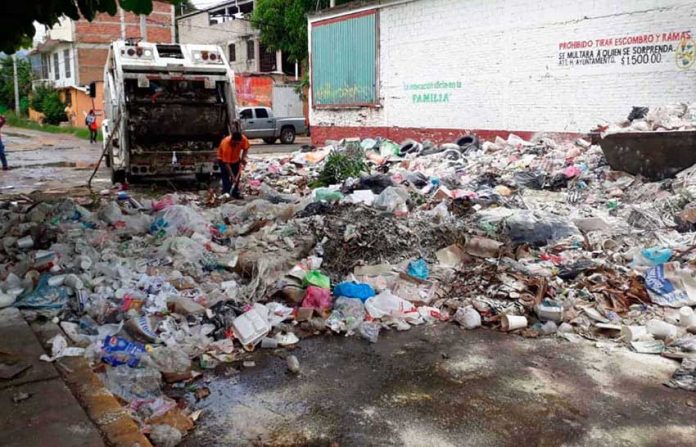In most of my life before Mexico I lived in a rural setting where it was dark at night and relatively quiet both day and night.
We caught the sound of a train whistle several times during any 24-hour period, but it was at a distance I considered quaint and therefore did not qualify as an obnoxious intrusion into my peace of mind. Coyotes singing in the meadows and the baritone burps of the bullfrogs I also considered to be a melodic backdrop essential for a life harmonious with nature and my inner being.
Then I moved to Mexico, where life goes forward with a cacophonous assault on the senses unimaginable to anyone north of the border. This culture embraces sound in all its forms from celebratory to martial to music to honking horns to blaring stereos to crowing roosters and barking dogs; if it’s loud it’s loved.
Of course, different areas of the country produce different sounds, but the continuous soundtrack that is exclusively Mexico’s is prevalent wherever you go.
The metropolitan areas have their own brand of a multi-layered sonic assault which differ in quality and quantity throughout any 24-hour period. The background thrum of life in smaller towns is certainly more subdued in its insistence to be heard, while the village culture creates a sonority more in tune with the natural world, that is, the natural world of Mexico where the sound of silence is non-existent.
A number of years ago I went with a friend to spend a couple of days in a mountain village with the thought of escaping the hubbub of Mazatlán’s city life, and immerse myself in the sounds of nature once again. It was this foray into the Sierra Madre which taught me there was no escaping the background soundtrack that is Mexico.
I had simply changed the channel from city noise to country noise; barking dogs, roosters stuck in a time warp and burros impersonating the terminal stages of whooping cough — all night long.
The next morning when I subtly questioned a couple of the villagers about the incessant caterwauling of the animals during the night, their brows wrinkled with incomprehension. They simply said, “But señor, how would we know? We are asleep during the nighttime.”
It was then I realized that the natives are equipped with a volume control to modulate the soundtracks of their lives. Turn it up for fiestas, and then off at night; a very convenient trait of cultural evolution refined over the last 487 years.
Anyone who has walked down a street in a Mexican town or city can attest to the fact that many retailers believe large speakers, blaring music into the streets, will attract shoppers like sailors to sirens. They are appealing to the fiesta side of the instinctive volume control to lure shoppers through their doors.
Apparently the unsuspecting person will automatically tune out bus horns, traffic noise, screeching brakes, shouting vendors and home in on the blaring speakers which will transport them into retail bliss.
It took me a few years to fully appreciate the level of indoctrination the average Mexican has endured over a lifetime, and it is significant. But where did this propensity for life at full volume arise? And how is it that so many people can sleep so soundly through so much noise?
By the time the Spanish arrived in 1531, the natives of this country had been pleasing large crowds by publicly cutting the hearts from living people for several centuries. As the ancestral genetics of the brutal Spaniards mingled with what was left of the population of bloodthirsty natives, a culture was forged by conflict, carnage, strife, revolutions and wars over the following centuries.
All these violent activities produced a tremendous amount of noise: cannons, bombs, rifles, pistols, the screams of the dying and the cries of the living; large-scale slaughter is a very noisy business. And, to preserve what little sanity the peoples of the past possessed, they learned to shut out the deleterious noise of their difficult lives while still embracing the raucous fanfare of their celebratory occasions, even in the grimmest of times.
With this selective auditory capability also came the resourcefulness of this culture to achieve a considerable amount of noise when called upon to do so. Before living in Mexico, I had never contemplated the multitudinous ways noise could be generated by just one resolute person, let alone the capabilities of a serious group.
When Mexicans celebrate one of their many martial or religious holidays, the population does not sit quietly while reflecting on the horrors of war (or the glorious successes of insurgencies) or contemplating God. No, they celebrate these milestones with a stunning array of ways to create as much noise as humanly possible and then parade it through the center of town.
Mexican parades can be extravagant affairs with lavish floats sporting huge sound arrays, or with simply a single truck with speakers in the back, followed by a group of villagers thoroughly enjoying their homespun spectacle. But in either case, you can bet the speakers will be abundant, and maxed out.
This inimitable relationship Mexicans have with sound/noise manifests itself in some interesting ways. Throughout Mexico, roving venders drive through neighborhoods, six days a week, hawking their goods through amplified loudspeakers. Sometimes it is rapid-fire Spanish, incomprehensible to my muddled gringo mind, or it might be a dreadfully catchy tune on a short tape loop.
For example, when I hear the theme from The Good, The Bad & The Ugly I know the gas truck is coming through the neighborhood. The vendors have identified themselves, each with their own high-decibel, signature noise. As a gringo, I hear each and every one of the vendors plying our neighborhood.
However, I now know that my Mexican neighbors only perceive the sound of vendors whom they wish to deal with. This selective hearing thing is quite clever, because this grade of neighborhood disturbance would draw fire in any place in the U.S.A.
There are also several types of panhandlers who produce noise with the expectation of a monetary reward for something far from melodious. One of my favorites is a twisted gnome of a man with a Coke bottle and a stick who wanders the beaches of the tourist zone. He will approach tourists with a sparsely-toothed grin, place the bottle on his shoulder violin style, and then proceed to run the stick up and down his glass instrument while barking out words of some tune only known to him.
A Oaxaca gas truck plays its distinctive tune, preceded by a mooing cow.
Religious holidays will bring out a family act with a husband, wife and a couple of small children. These wandering minstrels, dressed in threads and patches, are armed with a battered bugle, a snare drum and a rusty tambourine.
This mendicant clan makes no attempt at music, they simply wander into a neighborhood and begin making as much discordant noise as possible. Then one of the children is sent door to door with hat in hand.
I thought that by this time of life I would be living at least the first part of the Desiderata: “Go placidly amid the noise and haste, and remember what peace there may be in silence.”
I’m not. But at least I am looking forward to getting older so that my hearing is no longer so acute. And besides, life in Mexico would be boring without the definitive soundtracks which accompany us on a daily basis.
The writer describes himself as a very middle-aged man who lives full-time in Mazatlán with a captured tourist woman and the ghost of a half wild dog. He can be reached at [email protected].









